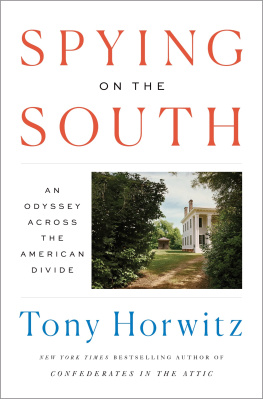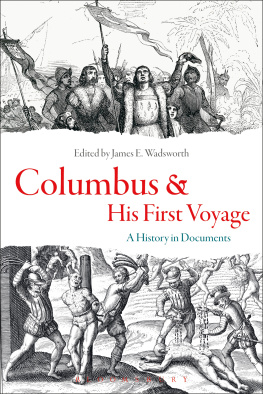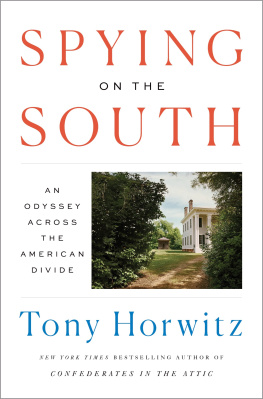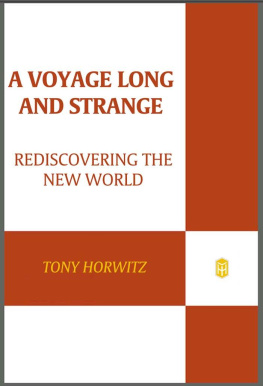A VOYAGE
LONG AND
STRANGE
REDISCOVERING THE NEW WORLD

TONY HORWITZ
H ENRY H OLT AND C OMPANY
N EW Y ORK

Henry Holt and Company,
LLC Publishers since 1866
175 Fifth Avenue New York, New York 10010
www.henryholt.com
Henry Holt and  are registered trademarks of Henry Holt and Company, LLC.
are registered trademarks of Henry Holt and Company, LLC.
Copyright 2008 by Tony Horwitz
All rights reserved.
Published simultaneously in the United Kingdom by John Murray
Sections of chapters 8 and 9 were originally published
in different form in Mens Journal.
Distributed in Canada by H. B. Fenn and Company Ltd.
Library of Congress Cataloging-in-Publication Data
Horwitz, Tony, 1958
A voyage long and strange: rediscovering the new world/Tony Horwitz.1st ed.
p. cm.
Includes bibliographical references and index.
ISBN-13: 978-0-8050-7603-5
ISBN-10: 0-8050-7603-4
1. AmericaDiscovery and exploration. 2. North AmericaDiscovery and exploration. 3. ExplorersAmericaHistory. 4. ExplorersNorth AmericaHistory.
I. Title.
E101.H77 2008
Henry Holt books are available for special promotions and premiums.
For details contact: Director, Special Markets.
First Edition 2008
Designed by Meryl Sussman Levavi
Printed in the United States of America
1 3 5 7 9 10 8 6 4 2
To Erica and Josh, bread in the backseat
sandwich of our childhood travels.
Mistakes... are the portals of discovery.
James Joyce, Ulysses
Pray look better, sir, quoth Sancho; those
things yonder are no giants, but windmills.
Miguel de Cervantes, Don Quixote
CONTENTS
PART I
DISCOVERY
PART II
CONQUEST
PART III
SETTLEMENT
MAPS
A VOYAGE
LONG AND
STRANGE
PROLOGUE
THE LOST CENTURY
T HE PILGRIMS DIDN T think much of Cape Cod. A hideous and desolate wilderness, William Bradford called it. Full of wild beasts and wild men. Rather than stay, a small party from the Mayflower sailed ahead, searching for a winter haven. In December 1620, they reached Plymouth, a place fit for situation, Bradford wrote. At least it was the best they could find.
On a New England road trip a few summers ago, I washed up in Plymouth, too. It could have been Dedham or Braintree or some other pit stop on the highway near Boston. But a Red Sox game pulsed on the radio, so I drove until it ended at the Plymouth exit. Stopping for beer at Myles Standish Liquor, I was directed to the William Bradford Motor Inn, the best I could find in peak tourist season.
Early the next morning I went for a walk along the waterfront, past a chowder house, a saltwater taffy shop, a wax museum, and a replica Mayflower moored in the bay. Near the water stood a gray historic marker that was terse even by New England standards.
Plymouth Rock. Landing Place of the Pilgrims. 1620.
I looked around and couldnt see anything except asphalt and a few stones small enough for skipping. Then I spotted a lone speed-walker racing down the sidewalk. Excuse me, I said, chasing after him, but wheres Plymouth Rock?
Without breaking stride, he thrust a thumb over his shoulder. You just passed it.
Twenty yards back was a columned enclosure, between the sidewalk and shoreline. Stepping inside, I came to a rail overlooking a shallow pit. At the bottom sat a lump of granite, the wet sand around it strewn with cigarette butts and ticket stubs from the wax museum. The boulder, about five feet square, had a badly mended cleft in the middle. It looked like a fossilized potato.
A few minutes later a family arrived. As they entered the portico, the father intoned to his children, This is where it all began. Then they peered over the rail.
Thats it?
Guess so.
Its, like, nothing.
Weve got rocks bigger than that in our yard.
Before long, the portico was packed: tour bus groups, foreign sightseers, summer campers. Their response followed the same arc, from solemnity to shock to hilarity. But Plymouth Rock was an icon of American history. So visitors dutifully snapped pictures or pointed video cameras down at the static granite.
Thats going to be one heckuva home movie.
Yeah. My Visit to Plymouth Pebble.
The Pilgrims must have had small feet.
I went over to chat with a woman in green shorts and tan shirt standing outside the enclosure, counting visitors with a hand clicker. Claire Olsen was a veteran park ranger at Plymouth, accustomed to hearing tourists abuse the sacred stone. A lot of people come here expecting the Rock of Gibraltar, she said. Maybe thats where they went on their last vacation.
She was also accustomed to fielding odd questions. Was it true that the Mayflower crashed into Plymouth Rock? Did the Pilgrims serve Thanksgiving on top of it? The bronze, ten-foot-tall Indian on a hill overlooking the rockwas he life-sized?
The most common question, though, concerned the date etched into the rocks surface. Why did it say 1620, visitors wondered, rather than 1492? Wasnt that when Columbus arrived?
Or they ask, Is this where the three ships landed? Claire said. They mean the Nia, the Pinta, and the Santa Mara. People think Columbus dropped off the Pilgrims and sailed home.
Claire had to patiently explain that Columbuss landing and the Pilgrims arrival occurred a thousand miles and 128 years apart. Americans learn about 1492 and 1620 as kids and thats all they remember as adults, she said. The rest of the story is blank.
As she returned to counting tourists, I returned to the Governor Bradford, chuckling over visitors questions. America, great land of idiocy! But Claires parting comment gave me pause. Back on the road, winding past cranberry bogs, I scanned the data stored in my own brain about Americas founding by Europeans. In fourteen hundred and ninety-two, Columbus sailed the ocean blue... John Smith and Jamestown... the Mayflower Compact... Pilgrims in funny hats... Of the Indians who met the English, I of course knew Pocahontas, Squanto, and... Hiawatha?
That was the sum of what I dredged up. Scraps from elementary school and the Thanksgiving table. Plus some fuzzy, picture-book images of black-robed friars and armored conquistadors I couldnt identify. As for dates, Id mislaid an entire century, the one separating Columbuss sail in 1492 from Jamestowns founding in 16-0-something. Maybe nothing happened in the period between. Still, it was distressing not to know. Expensively educated at a private school and universitya history major, no less!Id matriculated to middle age with a third graders grasp of early America.
Returning home to Virginia, I resolved to undertake some remedial study. At first, this proved deceptively easy: most of what I wanted to know was hiding in plain sight, at my local library. After skimming a few histories, I dug deeper, reading the letters and journals of early explorers. A cinch, reallyexcept, an awful lot happened between Columbus and the Pilgrims. Incredible stories Id known nothing about. This wasnt a gap in my education; it was a chasm.












 are registered trademarks of Henry Holt and Company, LLC.
are registered trademarks of Henry Holt and Company, LLC.